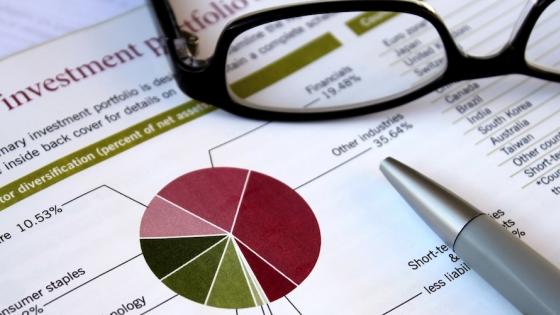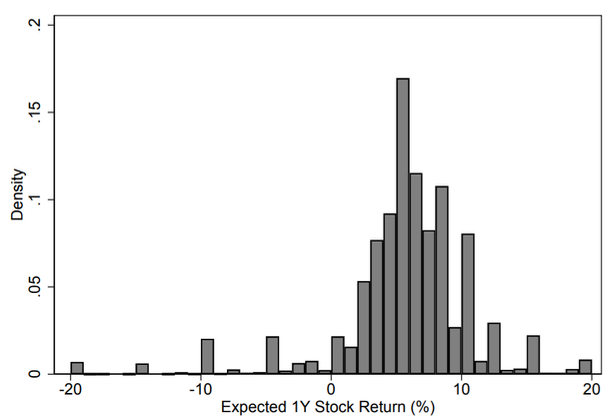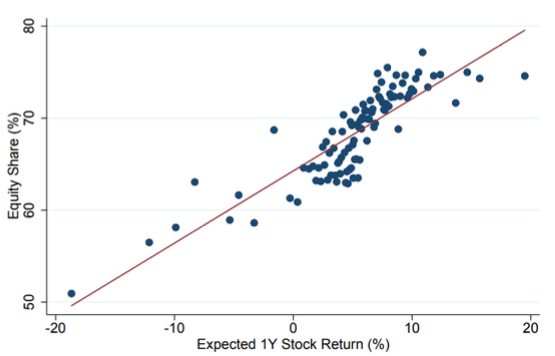How investors form expectations, how these expectations are reflected in portfolio choices, and how these portfolio choices aggregate to determine asset prices are central questions in both the behavioural and rational approaches to financial economics (Shiller 2013, Fama 2013).
In recent years, a number of studies have explored these questions using survey-elicited beliefs. One of the challenges faced by this new literature has been the limited availability of large-scale surveys that also contain information about individuals’ actual behaviour. While progress has been made on how investors’ expectations evolve, we know much less about how these expectations are reflected in subsequent behaviour, even though such quantity movements are central for belief changes to affect prices.
To overcome this data challenge, we administer an online survey to Vanguard customers to elicit their beliefs about future stock returns, GDP growth, and bond returns; we also match these survey responses to anonymised data on survey respondents’ portfolios and trading patterns (Giglio et al. 2019). Vanguard retail brokerage and retirement account customers are randomly selected to participate in the survey, which started in February 2017 and is still ongoing. In the first draft of our paper, we explored the first ten waves of the survey, which received a total of 20,207 responses. If a customer responded to any wave, she was contacted again in subsequent waves. This provides our survey with a substantial panel component. Approximately 35% of responses came from investors who responded to only one survey. Over 25% percent of respondents participated in at least four survey waves.
The average expected one-year US stock market return among survey participants was 5.23%, with substantial heterogeneity among respondents (see Figure 1): the expected return is 0.5% at the 10th percentile and 10% at the 90th percentile. Our first study focuses on understanding the implications of this cross-sectional heterogeneity of beliefs, and thereby complements existing studies focused primarily on exploring the time-series of average beliefs.
Figure 1 Distribution of expected one-year stock returns
Note: Across all survey waves. Mean = 5.23%. Standard Deviation = 5.32%.
One central contribution of our work is to study the extent to which the survey-elicited beliefs correspond to individuals’ portfolio allocations. Figure 2 shows a strong positive relationship between an investor’s expectation of the following year’s return on a stock portfolio and her portfolio’s composition. The share of the portfolio allocated to equities shows relatively less sensitivity to changes in expected return compared with predictions from frictionless benchmark macro-finance models. On average, an investor expecting a 1 percentage point increase in returns over the next year has portfolio equity holdings that are about 0.7 percentage points larger.
Figure 2 Expected one-year stock returns and equity share
Note: Figure shows a conditional binscatter plot of survey respondents’ expected one-year stock returns and the equity share in their portfolios, conditional on the respondents’ age, gender, region, wealth, and the survey wave.
While the average sensitivity of portfolios to beliefs is lower than that found in frictionless models, substantial heterogeneity exists in the quality of sensitivity across investors. Interestingly, variations in sensitivity line up with the different frictions investors face. Investors who paid more attention to their accounts, investors who traded more frequently, and investors who were more confident in their beliefs all had portfolios that aligned more strongly with their expected stock returns. Portfolios in tax-advantaged accounts were more sensitive to changes in investors’ expectations than portfolios subject to capital gains taxes, especially if holdings exceeded $100,000. Portfolios in institutionally managed defined-contribution plans showed about half the sensitivity to changes in expectations than portfolios in individually managed plans. Indeed, when we focused on a subset of investors who faced few of these frictions, we found that their portfolio allocations aligned with their beliefs in a way that is quantitatively similar to the predictions from frictionless models. The fact that survey responses and portfolio allocations don’t vary as much, on average, as predicted by frictionless models is not a problem to do with survey data. Rather, for models to have reliable quantitative implications, they need to better account for the large and heterogeneous frictions across investors.
The significant differences in beliefs across individual responses apparent from Figure 1 are persistent within individuals as well: optimists remain optimistic over time, pessimists remain pessimistic, and their beliefs are persistently far apart. Indeed, individual-fixed effects account for more than half of the panel variation in expectations. While optimism and pessimism appear to be persistent individual characteristics, it is hard to predict who is an optimist and who is a pessimist using observable characteristics such as gender, age, wealth, or geographic location.
The survey also elicited expectations on topics other than stock returns, and individual expectations tend to correlate across responses. Beliefs about GDP growth and short- and long-run stock expectations are positively correlated. Pessimists who believe a stock market disaster is more likely also expect lower future cash flows and lower future returns. These patterns across answers from the same individuals further strengthen the notion that individuals can be grouped into types – optimists and pessimists – whose attitudes extend across related domains, from stock returns to GDP and interest rates.
Our research supports the notion that survey data reveal beliefs relevant for actual investor behaviour, underscoring the potential for survey data to inform macro-finance theories. Our findings also highlight the presence of persistent heterogeneity in beliefs, as well as revealing predictable differences across individuals in how beliefs are reflected in portfolio allocations. This suggests that incorporating such heterogeneity into our asset-pricing models might help us to better match price and quantity data jointly.
References
Fama, E F (2013), “Two Pillars of Asset Pricing”, Nobel Prize Lecture
Giglio, S, M Maggiori, J Stroebel and S Utkus (2019), “Five Facts about Beliefs and Portfolios”, NBER Working Paper 25744
Shiller, R J (2013), “Speculative Asset Prices”, Nobel Prize Lecture









